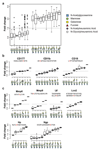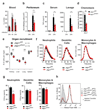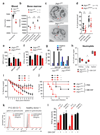Jagunal homolog 1 is a critical regulator of neutrophil function in fungal host defense
- PMID: 25129145
- PMCID: PMC6245568
- DOI: 10.1038/ng.3070
Jagunal homolog 1 is a critical regulator of neutrophil function in fungal host defense
Abstract
Neutrophils are key innate immune effector cells that are essential to fighting bacterial and fungal pathogens. Here we report that mice carrying a hematopoietic lineage-specific deletion of Jagn1 (encoding Jagunal homolog 1) cannot mount an efficient neutrophil-dependent immune response to the human fungal pathogen Candida albicans. Global glycobiome analysis identified marked alterations in the glycosylation of proteins involved in cell adhesion and cytotoxicity in Jagn1-deficient neutrophils. Functional analysis confirmed marked defects in neutrophil migration in response to Candida albicans infection and impaired formation of cytotoxic granules, as well as defective myeloperoxidase release and killing of Candida albicans. Treatment with granulocyte/macrophage colony-stimulating factor (GM-CSF) protected mutant mice from increased weight loss and accelerated mortality after Candida albicans challenge. Notably, GM-CSF also restored the defective fungicidal activity of bone marrow cells from humans with JAGN1 mutations. These data directly identify Jagn1 (JAGN1 in humans) as a new regulator of neutrophil function in microbial pathogenesis and uncover a potential treatment option for humans.
Conflict of interest statement
The authors declare no competing financial interests.
Figures




Similar articles
-
A crucial role for Jagunal homolog 1 in humoral immunity and antibody glycosylation in mice and humans.J Exp Med. 2021 Jan 4;218(1):e20200559. doi: 10.1084/jem.20200559. J Exp Med. 2021. PMID: 32930709 Free PMC article.
-
JAGN1 is required for fungal killing in neutrophil extracellular traps: Implications for severe congenital neutropenia.J Leukoc Biol. 2018 Dec;104(6):1199-1213. doi: 10.1002/JLB.4A0118-030RR. Epub 2018 Aug 14. J Leukoc Biol. 2018. PMID: 30106500
-
Case report: Granulocyte-macrophage colony-stimulating factor sargramostim did not rescue the neutrophil phenotype in two patients with JAGN1-mutant severe congenital neutropenia.Front Immunol. 2024 Sep 2;15:1373495. doi: 10.3389/fimmu.2024.1373495. eCollection 2024. Front Immunol. 2024. PMID: 39286252 Free PMC article.
-
Modulation of neutrophil function in host defense against disseminated Candida albicans infection in mice.FEMS Immunol Med Microbiol. 1999 Dec;26(3-4):299-307. doi: 10.1111/j.1574-695X.1999.tb01402.x. FEMS Immunol Med Microbiol. 1999. PMID: 10575142 Review.
-
JAGN1 mutation with distinct clinical features; two case reports and literature review.BMC Pediatr. 2023 Apr 29;23(1):206. doi: 10.1186/s12887-023-04024-y. BMC Pediatr. 2023. PMID: 37120535 Free PMC article. Review.
Cited by
-
A crucial role for Jagunal homolog 1 in humoral immunity and antibody glycosylation in mice and humans.J Exp Med. 2021 Jan 4;218(1):e20200559. doi: 10.1084/jem.20200559. J Exp Med. 2021. PMID: 32930709 Free PMC article.
-
Glycans Instructing Immunity: The Emerging Role of Altered Glycosylation in Clinical Immunology.Front Pediatr. 2015 Jun 11;3:54. doi: 10.3389/fped.2015.00054. eCollection 2015. Front Pediatr. 2015. PMID: 26125015 Free PMC article. Review.
-
Revisiting the immunopathology of congenital disorders of glycosylation: an updated review.Front Immunol. 2024 Mar 14;15:1350101. doi: 10.3389/fimmu.2024.1350101. eCollection 2024. Front Immunol. 2024. PMID: 38550576 Free PMC article. Review.
-
Immune Sensing of Candida albicans.J Fungi (Basel). 2021 Feb 6;7(2):119. doi: 10.3390/jof7020119. J Fungi (Basel). 2021. PMID: 33562068 Free PMC article. Review.
-
Akt-2 Is a Potential Therapeutic Target for Disseminated Candidiasis.J Immunol. 2022 Sep 1;209(5):991-1000. doi: 10.4049/jimmunol.2101003. Epub 2022 Aug 5. J Immunol. 2022. PMID: 36130126 Free PMC article.
References
-
- Borregaard N. Neutrophils, from marrow to microbes. Immunity. 2010;33:657–70. - PubMed
-
- Klein C. Genetic defects in severe congenital neutropenia: emerging insights into life and death of human neutrophil granulocytes. Annu Rev Immunol. 29:399–413. - PubMed
-
- de Boer J, et al. Transgenic mice with hematopoietic and lymphoid specific expression of Cre. Eur J Immunol. 2003;33:314–25. - PubMed
-
- Fulurija A, Ashman RB, Papadimitriou JM. Neutrophil depletion increases susceptibility to systemic and vaginal candidiasis in mice, and reveals differences between brain and kidney in mechanisms of host resistance. Microbiology. 1996;142(Pt 12):3487–96. - PubMed
Publication types
MeSH terms
Substances
Grants and funding
LinkOut - more resources
Full Text Sources
Other Literature Sources
Medical
Molecular Biology Databases
Research Materials

